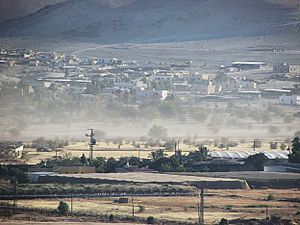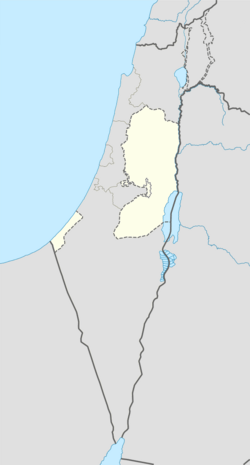Fasayil facts for kids
Quick facts for kids
Fasayil
|
|
|---|---|
|
Municipality type D (Village council)
|
|
| Arabic transcription(s) | |
| • Arabic | فصايل |
| • Latin | al-Fasa'il (official) Khirbet al-Fasayil (unofficial) |

View of Fasayil al-Fauqa (north Fasayil), 2014
|
|
| State | State of Palestine |
| Governorate | Jericho |
| Government | |
| • Type | Village council |
| Population
(2017)
|
|
| • Total | 1,637 |
Fasayil, also known as Fasa'il, is a village in the northeastern West Bank. It is part of the Jericho Governorate in Palestine. The village is about 14 kilometers (9 miles) northwest of Jericho. It is also about 40 kilometers (25 miles) southeast of Nablus. The closest Palestinian town is Duma to the west. In 2017, about 1,637 people lived in Fasayil.
Contents
Village Name and Meaning
The ancient name for Fasayil was Phasaelis. This name came from Phasael, who was the older brother of Herod the Great. Herod was a king who ruled the area a long time ago.
Fasayil Through History
Ancient Roman and Byzantine Times
Around 2,000 years ago, during the Roman period, King Herod the Great built a new city. He named it Phasaelis to honor his brother. Today, we can still see the ruins of this ancient city. Local people call these ruins Khirbet Fasayil. There is also a small hill called Tell Fasayil. This hill might have been a Byzantine monastery.
A historian named Josephus wrote about Phasaelis. He said it was part of an area ruled by Herod's sister, Salome I. Phasaelis is also shown on the Madaba Map. This is an old map from the 6th century. The map shows the city surrounded by date palm trees.
In 1949, the tomb of a religious hermit named Peter was found in the village. Hermits are people who live alone for religious reasons. The ruins of a monastery dedicated to Saint Cyriacus are also in Fasayil. Saint Cyriacus was a monk who died in 556 AD. There is a large square building among the ruins. Today, only its outline can be seen because it is mostly buried. Near the village, there is a pool and many old wall remains. This area is called Tell Sheikh ad-Diab. It is named after a Muslim holy man whose tomb is still there.
Early Muslim Period
A stone found in Fasayil tells us about a building project. This project was dedicated to Khumarawayh ibn Ahmad ibn Tulun. It was likely started between the years 884 and 896 AD.
Crusader Period
In the 13th century, a monk named Brocardus mentioned Fasayil. He called it a small village named Pheselch. Later, in the 14th century, Marino Sanuto also called it a small village named Fasaelis.
Late Ottoman Period
In 1870, a traveler named Victor Guérin visited Fasayil. He found the place in ruins. In 1874, explorers from the PEF also visited. They described the many ruins they saw there.
After 1967
Since the Six-Day War in 1967, Fasayil has been under Israeli administration.
Village Parts and People
Modern Fasayil has three main parts. These are Fasayil al-Tahta (Lower Fasayil), Fasayil al-Fauqa (Upper Fasayil), and Fasayil al-Wusta. Fasayil al-Wusta was started in 1998 by Bedouins. Bedouins are groups of people who traditionally live a nomadic life. Many of these Bedouins had to leave their original lands in the 1940s and 1950s.
Many people living in Fasayil are officially registered as residents of the Bethlehem Governorate. A governorate is like a large administrative area or region. Until 1995, Fasayil was part of the Nablus Governorate. After 1995, it became part of the Jericho Governorate.
Land and Building Challenges
Some land from Fasayil has been used to build nearby settlements. For example, land was used for settlements like Tomer, Gilgal, Peza’el, and Nativ HaGdud.
In 2006, some shelters in Fasayil al-Wusta were removed. In 2008, more shelters were removed. Fasayil gained attention in 2007 when there were plans to remove the village's main school. Fasayil al-Wusta is in an area called Area C of the West Bank. In this area, building permits are needed from the authorities. The school was built without a permit. Residents often find it difficult to get permission to build in Fasayil al-Wusta.
Population Information
In 1931, the number of people in Fasayil was counted with a nearby village called Aqraba. This was also true in 1945. A census by Jordan in 1961 counted 318 residents in Fasayil.
After 1967, Israel conducted a census. It reported that Fasayil had 422 residents living in 92 homes. This included 257 people who were refugees. Refugees are people who have had to leave their homes.
According to a census in 1997, Fasayil had 648 people. About 31% of them were refugees who had left other parts of the West Bank in 1967. The population was almost equally split between males and females. In 2007, there were 1,078 people and 214 buildings in Fasayil.
See also
 In Spanish: Fasayil para niños
In Spanish: Fasayil para niños



